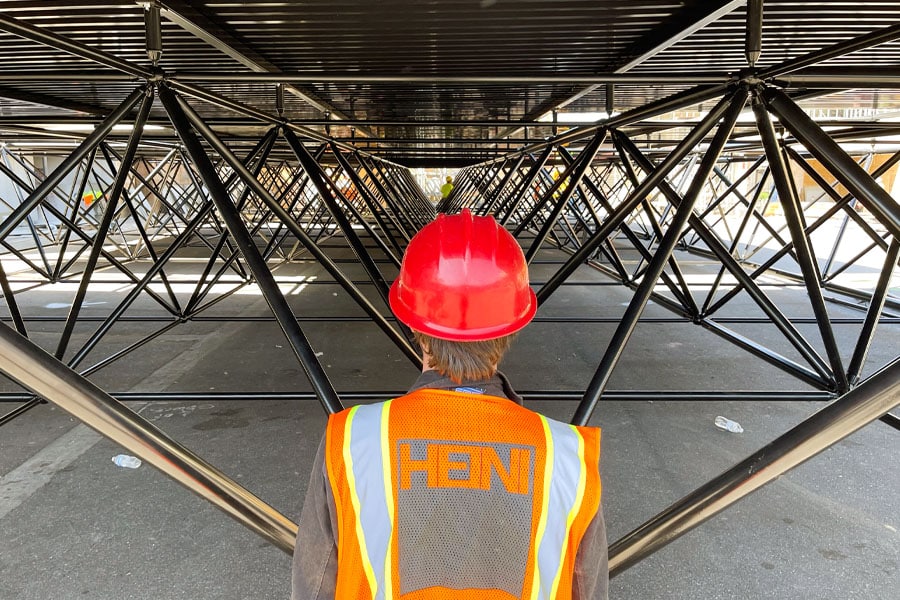At Riley Construction, a Wisconsin-based commercial family construction firm, building culture and employee engagement has long been a focus—especially emerging from the COVID-19 pandemic, when employees across industries started shifting their expectations about work.
No longer is the work experience just about what happens during their shifts. It’s about how it contributes to their overall quality of life, allowing them opportunities for growth and to add value on the job and in their communities. As a result, Riley has been laser-focused on building in the practices that create an environment of trust, encourage innovation and ensure everybody has access to career development, according to Chris Meier, a Riley project executive.
These days, when firms don’t address engagement, they are at a disadvantage amid labor shortages and growth forecasts for the industry. “The fear of not meeting those [worker] expectations is you have either a restless workforce or you have difficulty maintaining the resources that you need to perform the work that we see on the horizon,” Meier said.
Why engagement matters
Engaged workers, who are committed to doing well on the job, boost a company’s productivity and profitability, according to Gallup. Yet worker productivity has been down, according to the U.S. Bureau of Labor Statistics. And in construction, the news is much worse, according to a 2023 report, “The Strange and Awful Path of Productivity in the U.S. Construction Sector.”
The report’s authors, Chicago Federal Reserve President Austan Goolsbee and Chad Syverson, a University of Chicago professor, found that a construction worker in 2020 was 40% less productive than one in 1970. Syverson told The New York Times that “multiple problems” are at play. More regulations, paperwork and safety requirements could be among them, the Times article surmised—and there are no easy fixes.
As organizations across industries grapple with productivity issues, they’ll need to tackle the issue from every angle, including ensuring that they’re giving workers a reason to be engaged and motivated on the job.
An engaged workforce is possible when workers see that their contributions are valued and their needs are met—from the tools and skills required for the job to a positive work-life balance. Here’s how two construction companies are building engagement.
Measure it
For the past decade, McCarthy Building Companies has deployed engagement surveys, asking employees directly about their on-the-job motivation levels and needs, said Becky Graves, director of McCarthy’s culture imperative.
Full engagement surveys, which are sent every few years, might wade into whether employees feel like their responsibilities match their career goals, whether they have the tools they need and what kind of relationship they have with their managers.
Pulse surveys are sent out more frequently and typically focus on one topic, such as the employee-manager relationship or whether they understand how their job helps the company achieve success.
The data can be sliced and diced, so leaders can uncover pockets of the workforce—a team or location—that might need some encouragement or additional support. Results spark action, Graves said. When a pulse survey revealed workers wanted better relationships with their managers, McCarthy rolled out an employee-manager connection program.
Communicate with trades workers
In construction, it may be easier to engage office staff, who can pop in to training programs or more easily ask human resources a question. To ensure tradespeople feel included and informed and are successful, McCarthy has boosted its communication methods with them—adding social media, a chat function for texting and a dedicated HR Service Center to answer their questions. The goal is “making sure that employees’ needs were met so that we could meet our clients’ needs, and that ultimately provides a service to the community,” Graves said.
Encourage innovation
To cultivate what Graves calls a “continuous improvement mindset,” McCarthy’s “Spark Tanks” let any employee submit an idea for the company; a committee in their region considers it. If the idea is approved, the person who submitted it is part of the implementation. “It can be incremental change,” Graves said. “It doesn’t have to be a revolutionary idea that would change the company overall.”
Recently implemented ideas include a new option to donate company swag to charity and an interactive map that shows where all of McCarthy’s projects are located.
Inspire ongoing improvement
Riley makes strategic investments in technology and new equipment to streamline tasks and support workers, but it also ensures the dialogue is always open for field leaders and workers to make changes that improve efficiency. When projects start and finish, for example, the company will hold team meetings to identify the required tasks and, at the end, find ways to improve on the process. “And in the next opportunity, we will bring an improved approach to the work,” Meier said.
Promote career development
To ensure that workers are aware of career growth opportunities and can pursue them, Riley is in the process of reinforcing individual development plans that outline growth plans for each employee. “That makes sure that we have a process by which our employees know that there’s an opportunity for career development and it’s openly communicated with regular process updates,” Meier said. “And, as managers and as executives, we regularly check in on the resources needed for those employees to achieve those development goals.”
Create a culture of generosity
At Riley, a “culture of generosity” includes rewarding great work through employee awards and events, and supporting active participation in the communities it serves. Riley “encourages our employees to engage in their interests that they have outside of work, participate in charities that they find important and, internally, celebrate goals achieved,” Meier said. And that gets to what employees want these days—a work life that positively impacts their overall quality of life. “Our company is here to support every employee, both personally and professionally,” Meier said, “and certainly lives up to being a family company.”












